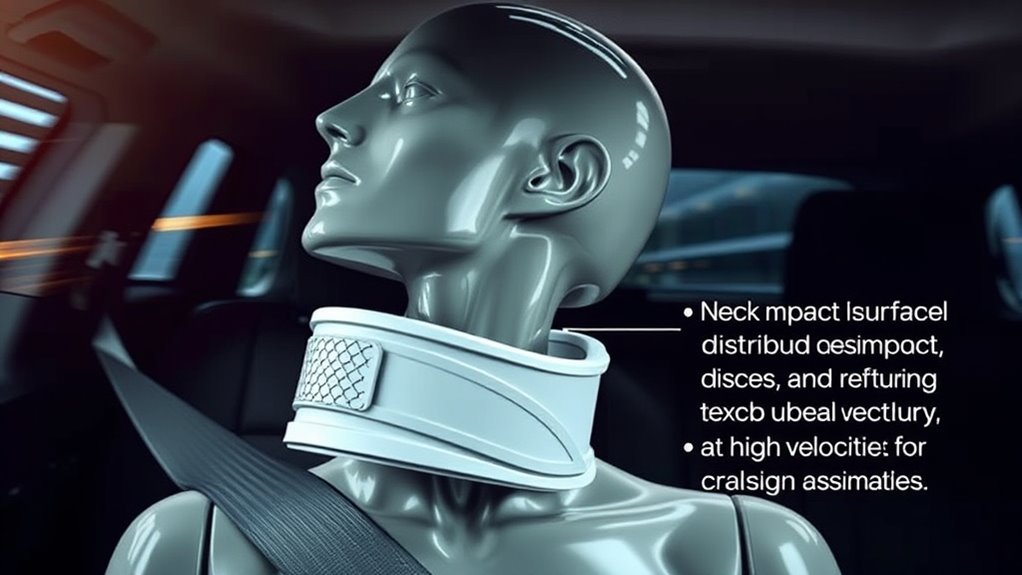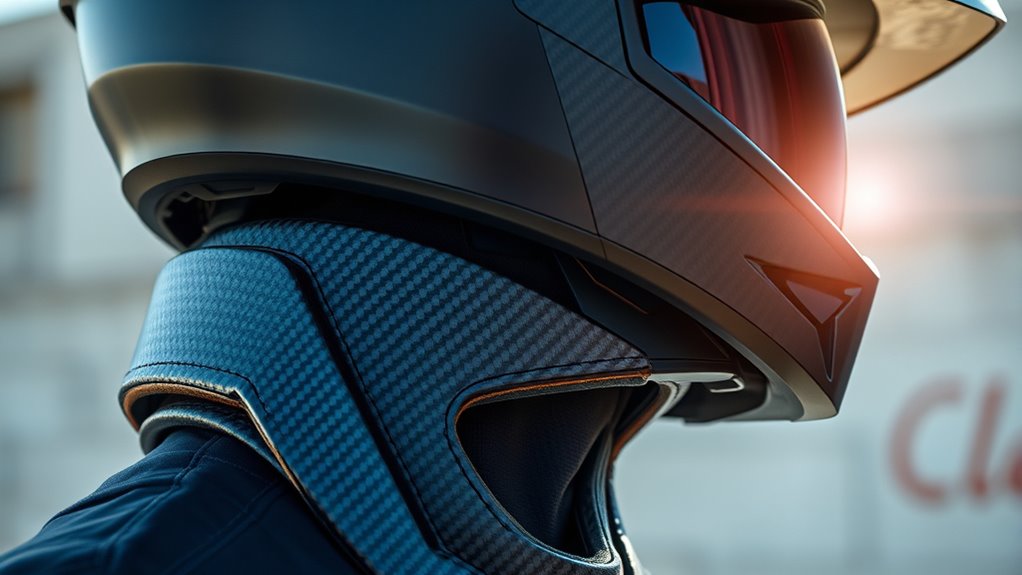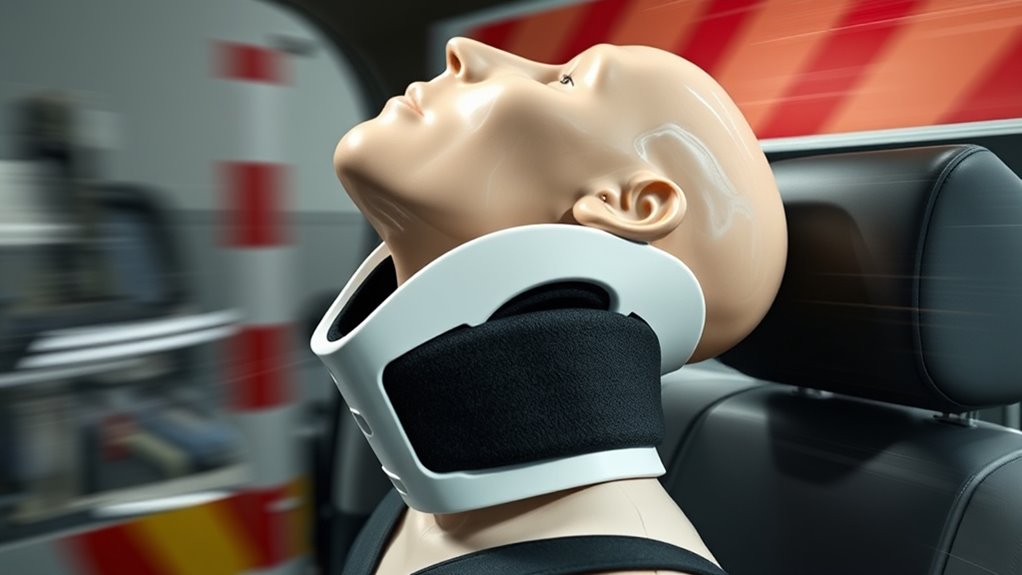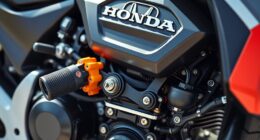Neck braces reduce crash forces at high speeds by absorbing and dissipating impact energy through materials like foam padding and flexible joints. They limit sudden head movements, preventing hyperextension or flexion that could cause injury. Their sturdy design spreads crash forces over a broader area, lowering the force transmitted to your neck and brain. To discover how specific features optimize protection and guarantee safety, keep exploring the details behind their design and use.
Key Takeaways
- Neck braces absorb impact energy through deformable materials, reducing the force transferred to the neck during crashes.
- They distribute collision forces over a broader area, minimizing localized stress on neck structures.
- Impact-absorbing components like foam and gel dissipate crash energy, decreasing peak impact forces.
- The design limits head movement, preventing sudden jerks that could amplify crash forces on the neck.
- Proper fit and secure straps ensure the brace effectively manages crash forces at high speeds.
The Role of Neck Braces in Impact Absorption

Neck braces play a vital role in absorbing impact forces during a crash. When a collision occurs, your neck experiences sudden, intense forces that can cause severe injury. The brace acts as a shock absorber, distributing these forces across a broader area to reduce strain on your cervical spine. By stabilizing your head and neck, it prevents excessive movement that could worsen injuries. The materials and design of the brace are engineered to deform slightly under impact, dissipating energy and minimizing transfer to your neck. This absorption process helps protect delicate nerves and spinal structures. Additionally, selecting proper safety equipment can significantly enhance injury prevention efforts. Ultimately, the neck brace’s primary function is to lessen the severity of impact forces, providing essential support during the critical moments immediately following a crash.
How Neck Braces Limit Head Movement During Crashes

When a sudden impact occurs, the primary goal of a neck brace is to control and limit head movement. It acts as a barrier that prevents your head from jerking violently in any direction. By stabilizing your neck, the brace distributes the forces across your cervical spine, reducing the risk of excessive movement. This helps prevent dangerous hyperextension or hyperflexion, which can cause severe injuries like spinal fractures or nerve damage. The design of the brace ensures your head stays aligned with your spine, even during sudden stops or twists. This restriction minimizes the acceleration forces transferred to your brain, decreasing the chance of concussions or other traumatic brain injuries. Essentially, the neck brace keeps your head from moving unpredictably, offering critical protection during crashes. Incorporating principles from ethical hacking, such as thorough assessment and strategic design, helps improve the effectiveness of protective gear like neck braces.
Materials and Design Features That Enhance Protection

Choosing a neck brace with impact-absorbing materials can considerably reduce the force transferred during a crash. A secure fit design ensures the brace stays in place and provides consistent protection. Features like energy dissipation help spread out crash forces, minimizing injury risk. Incorporating high-quality grocery savings strategies can also help in maintaining access to the best protective gear.
Impact-Absorbing Materials
Impact-absorbing materials are crucial in designing neck braces that effectively protect against crash forces. These materials are engineered to dissipate energy, reducing the force transmitted to your neck during a collision. Foam padding, such as expanded polypropylene or foam composites, absorbs impact by compressing under pressure, preventing it from reaching sensitive tissues. Some braces incorporate gel-filled inserts that mold to your neck’s shape, offering additional cushioning. Lightweight, high-strength plastics like carbon fiber or reinforced polymers also help absorb shocks while keeping the brace manageable to wear. The combination of these materials creates a barrier that slows down and disperses crash energy, minimizing injury risk. Additionally, selecting appropriate materials aligned with safety standards ensures your neck brace provides maximum protection without sacrificing comfort.
Secure Fit Design
A secure fit is essential for maximizing a neck brace’s protective capabilities. When your neck brace fits snugly, it effectively limits excessive movement during a crash, reducing the risk of injury. Design features like adjustable straps and contoured shapes help guarantee the brace conforms to your neck and shoulders. Materials such as flexible plastics and foam padding keep the brace stable without sacrificing comfort. A well-designed fit prevents the brace from shifting or slipping, which could compromise its protective function. Proper sizing and adjustable components allow you to customize the fit for your body, ensuring ideal support. When your neck brace fits securely, it works more efficiently, absorbing forces and minimizing strain during high-impact situations.
Energy Dissipation Features
How do neck braces effectively reduce injury during a crash? They incorporate energy dissipation features designed to absorb and spread out crash forces. Materials like impact-absorbing foam or specialized polymers help dampen sudden jolts, preventing excessive strain on your neck. Some braces include shock-absorbing inserts that compress on impact, reducing the transfer of force to your cervical spine. Design elements, such as crumple zones or flexible joints, allow controlled deformation during a crash, dispersing energy safely. These features work together to limit the peak forces transmitted to your neck, lowering injury risk. By converting crash energy into manageable deformation, these dissipation features make your neck brace a vital protective tool during high-speed impacts. Understanding heat pump technology and its efficiency ratings can also help in designing better protective gear by ensuring optimal performance and safety.
The Physics Behind Force Reduction at High Speeds

When you’re traveling at high speeds, your body carries a lot of momentum and energy that can cause serious injury during a crash. Force reduction methods work by dissipating this energy, lowering the impact force on your neck and spine. Understanding how impact force attenuation helps explain why certain neck brace designs are so effective in crash scenarios. Incorporating impact force attenuation techniques in neck brace design enhances their ability to protect against injuries during high-speed impacts.
Momentum and Energy Dissipation
Understanding how momentum and energy dissipation work during a crash reveals why force impacts decrease at higher speeds. When your vehicle slows abruptly, kinetic energy is converted into other forms, like heat and deformation. This energy transfer spreads the force over a longer period, reducing peak impact. The table below illustrates how different factors influence energy dissipation:
| Speed (mph) | Energy Absorbed (Joules) | Force Impact (N) |
|---|---|---|
| 30 | Low | Moderate |
| 50 | Moderate | Reduced |
| 70 | High | Lower |
| 90 | Very High | Much Lower |
| 110 | Extreme | Minimal |
As speed increases, more energy must be dissipated, spreading force over time and decreasing the impact on your neck. Additionally, the process of energy dissipation is similar to how certain dog breeds with unique features, such as Golden Dachshunds, adapt to their environments by combining traits that improve resilience and flexibility.
Impact Force Attenuation
As your vehicle accelerates to higher speeds, the physics of impact force attenuation come into play, reducing the peak forces transmitted to your neck during a crash. When a collision occurs, the sudden deceleration creates a rapid transfer of force. Impact force attenuation involves absorbing and spreading this force over a longer period or larger area, lessening its severity. Neck braces help by increasing the time and distance over which your head and neck move during a crash, effectively reducing the force experienced. They act like shock absorbers, dispersing energy that would otherwise be concentrated in a small area. This controlled energy absorption minimizes the peak impact force, protecting your neck from trauma. The faster you’re traveling, the more essential this force attenuation becomes to prevent injury. Additionally, Kia Tuning modifications such as suspension upgrades can improve vehicle stability, further reducing the risk of severe impacts at high speeds.
Comparing Different Types of Neck Braces for Safety Efficiency

Have you ever wondered which neck brace offers the best protection during a crash? Different types vary in design and safety efficiency. Here’s a quick comparison:
Considering your activity and safety needs helps determine the best neck brace for protection.
- Hinged braces provide flexibility and limit excessive movement, reducing injury risk.
- Rigid braces offer maximum stability but can restrict motion, making them suitable for severe impacts.
- Soft collars are lightweight and comfortable but offer minimal crash protection.
- Hybrid designs combine features for balanced support and comfort, often improving crash force attenuation.
Choosing the right brace depends on your activity level, risk exposure, and mobility needs. Each type plays a essential role in reducing crash forces, but understanding their differences helps you make a safer choice. Incorporating remote work principles like ergonomic furniture and decluttered spaces can enhance overall safety and comfort in your environment.
Best Practices for Using Neck Braces to Maximize Safety

Using a neck brace correctly can considerably enhance its protective benefits during a crash. Make sure it fits snugly around your neck without causing discomfort or restricting your breathing. Adjust the straps so the brace stays in place but doesn’t cut off circulation. Always follow the manufacturer’s instructions for proper positioning. Before riding, check that the brace doesn’t shift or loosen when you move your head. Keep it clean and inspect for wear regularly. Don’t wear the brace over bulky clothing or gear that could interfere with fit. If you experience pain or discomfort, adjust the fit or consult a professional. Proper use ensures the brace absorbs crash forces effectively, reducing injury risk and maximizing your safety. Additionally, choosing a suitable safety gear that matches your activity and body type can further improve protection during an impact.
Frequently Asked Questions
How Do Neck Braces Affect Long-Term Cervical Spine Health?
You might wonder about neck braces and long-term cervical spine health. Wearing a neck brace can provide immediate support after an injury, helping prevent further damage. However, prolonged use without medical guidance may weaken neck muscles over time, potentially impacting long-term health. It’s crucial to follow your healthcare provider’s recommendations, use the brace correctly, and incorporate neck-strengthening exercises to maintain ideal cervical spine health in the long run.
Are Neck Braces Effective at All Crash Speeds?
Think of a neck brace like a sturdy shield in a storm; it’s designed to protect. At various crash speeds, neck braces can be effective, especially in moderate impacts. They help limit excessive movement, reducing injury risk. However, at very high speeds, their ability to fully prevent injury diminishes. So, while they’re valuable safety tools, they aren’t foolproof at all crash speeds, and proper precautions are always essential.
Can Neck Braces Be Customized for Different Body Types?
You can customize neck braces for different body types, ensuring a better fit and enhanced protection. Manufacturers often offer adjustable features or multiple sizes to accommodate various neck lengths and shapes. By tailoring the brace to your specific body, you improve comfort and support, reducing the risk of injury during impacts. Always choose a neck brace that fits well and consult with professionals for proper customization options suited to your body type.
Do Neck Braces Interfere With Other Safety Gear?
You might wonder if neck braces interfere with other safety gear. Generally, they don’t, because designers craft them to fit comfortably alongside helmets and padding. They’re built to be lightweight, flexible, and compatible, so you can wear your gear without sacrificing safety or mobility. When properly fitted, neck braces work in harmony with your gear, ensuring all-encompassing protection without getting in the way during your ride or activity.
What Are the Maintenance Requirements for Optimal Performance?
To keep your neck brace performing ideally, you need to inspect it regularly for signs of wear or damage. Clean it with mild soap and water, avoiding harsh chemicals. Make sure all straps and buckles are functioning correctly and fit snugly. Store it in a cool, dry place when not in use. Proper maintenance ensures your neck brace provides the protection you need during impacts at speed.
Conclusion
Wearing a neck brace can reduce crash forces by up to 50%, markedly lowering injury risk. By limiting head movement and absorbing impact, it keeps you safer at high speeds. Remember, proper use maximizes protection, so always follow best practices. Next time you gear up, think of how a simple device can make a big difference—like a 50% reduction in injury risk—giving you more confidence on the road or track. Stay safe and protected.









